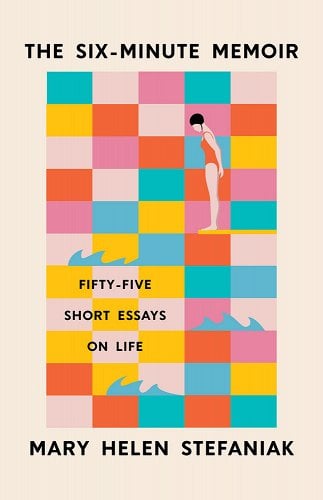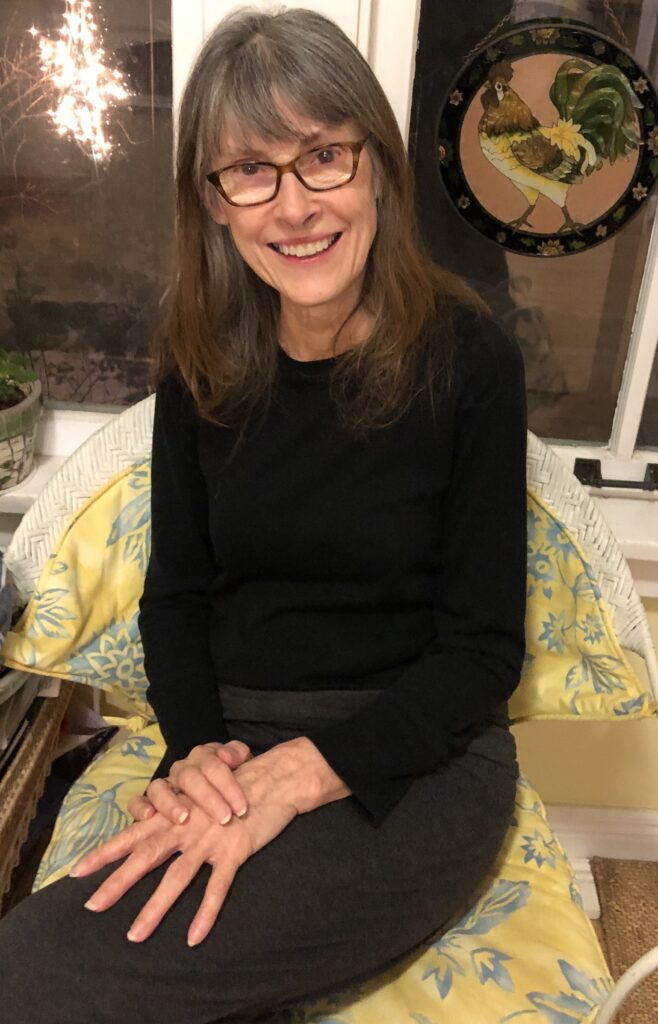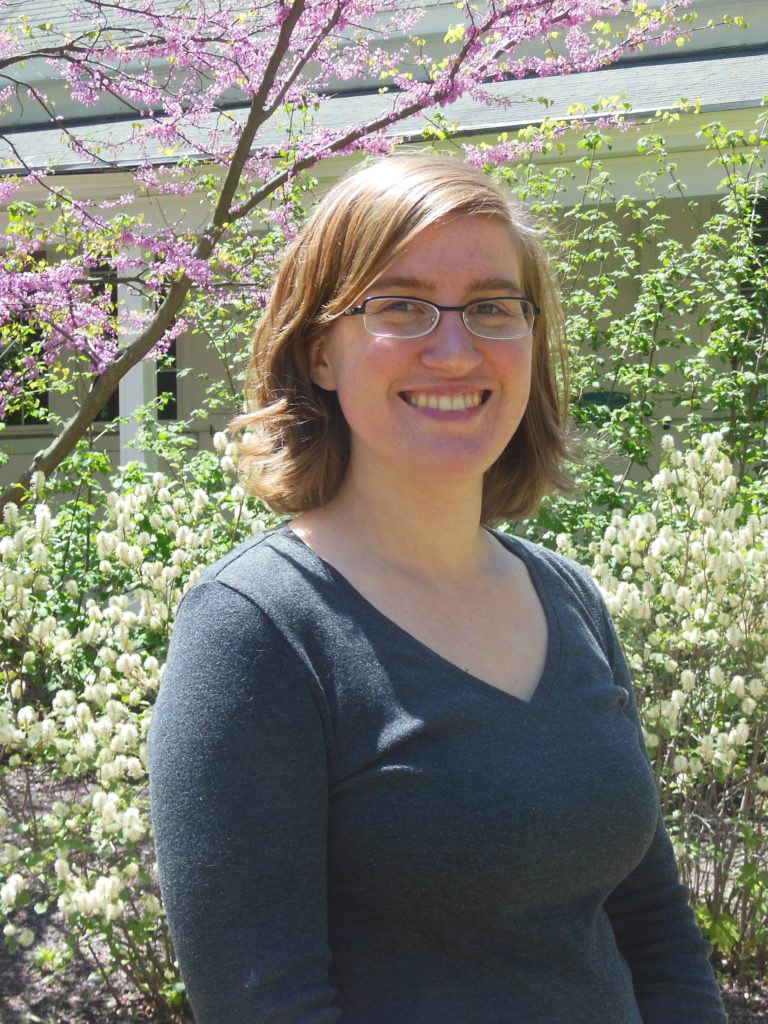Interview by Hillary Moses Mohaupt
 Mary Helen Stefaniak is a novelist, essayist, and writing teacher. A native of Milwaukee, Mary Helen now divides her time between Iowa City, where she and her husband John live in a 165-year-old stagecoach inn they restored, and Omaha, where she is Professor Emerita of English and Creative Writing at Creighton University. She teaches in the MFA program in writing at Pacific University in Oregon.
Mary Helen Stefaniak is a novelist, essayist, and writing teacher. A native of Milwaukee, Mary Helen now divides her time between Iowa City, where she and her husband John live in a 165-year-old stagecoach inn they restored, and Omaha, where she is Professor Emerita of English and Creative Writing at Creighton University. She teaches in the MFA program in writing at Pacific University in Oregon.
In October 2022, the University of Iowa Press released her first nonfiction book, The Six-Minute Memoir: Fifty-Five Short Essays on Life, a collection of essays selected from more than twenty years of her Alive and Well column in The Iowa Source. The book’s cover was recognized by Lithub as one of the best cover designs on 2022 – there are 55 squares, one for each of the essays in the collection. Each of the essays reflects not only the experience of one person who is, in fact, “alive and well in the middle of the Middle West” but also a specific outlook on the world that is at once specific and universal. Writing prompts at the end of the book encourage readers to capture moments from their own lives.
I spoke with Mary Helen Stefaniak, who was my writing teacher, not long before the first anniversary of the book’s publication. This interview has been edited for length and clarity.
Hillary Moses Mohaupt: The essays that appear in this book were written over the course of 20 years and were not originally published in the order in which they appear here. Tell me about the process of compiling these essays into a book. How did you decide the structure of this book?
Mary Helen Stefaniak: I had many more essays, maybe twice as many as what appeared here. It was during the pandemic that I put it together as a manuscript. I went through all the essays, chose the ones I liked best, and then I revised the ones I thought I needed to revise. And then I looked for how I could group them – some of them were obvious, like animals – and some of them could have fit in several different categories. It was like playing a game where you move things around. And, then, finally I came up with a title for the section that was punny or clever.
I hate to call the essays upbeat, because a lot of them are about serious and sad things. But they still somehow convey that I’m alive and well, which I think was somehow a good thing. I never had any thought when I was writing them that they would appear in a book, because it was a magazine column. I later found out that some of Joan Didion’s work was originally published in a magazine, and of course E. B. White was all in a magazine, so that was a perfectly respectful thing to do, to write a column. But I didn’t think that they would be a book. It was fun to discover that I could put them in these groups. I would ignore the dates completely and would put them in the kind of self that was being revealed, or the kind of self the speaker was in this one or that one.
And then I didn’t want the date when it was published to be terribly prominent, because I didn’t want the reader to be looking for a chronology. I argued for putting the date at the end of each essay, but the editors needed to have it at the beginning. When they sent me the proof, they had the date over on left and I thought, ‘no, no, they’ll read the title, then they’ll read the date,’ so you have to put it on the right so it’s subordinate.
There’s always this element of “she’s alive and well!” Grouping them made me feel as if my life had a certain coherence: there were patterns, and recurring themes.
HMM: What, if anything, surprised you as you re-encountered these essays? Was there anything that made you say, “a-ha!”?
MHS: Well, the a-ha came when a reader of the column commented that I seemed to be having so much fun. And I had been thinking, “oh, I’m struggling, I have a family, I’m a writer, I have this teaching job, life is hard, I’m making ends meet, plus we never go on vacation – isn’t that where you have fun?” And yet reading the essays again, going back through them, was fun, because they put me back in those moments. Discovering how alive and well I really was – that’s big. I spend more of my time worrying what’s not going well, what’s the thing you have to solve, what’s the future going to be like. So to realize you have all this fun – it’s hidden, and then just like the reader you get to enjoy it again. That was the biggest and best surprise. Discovering my many selves, too – the self who’s coloring her hair is different from the self who’s teaching French or building the house.
HMM: You mentioned earlier that you updated some of the essays for this book. Can you say more about that?
MHS: It was more like I polished them. I’d spend days on a couple of sentences. But I had the luxury of doing that because I had the bulk of it written. I only amended two of them – I added an author’s note to one and a postscript to another. The author’s note is sort of correcting myself, the way my sister saw it, and that becomes important because it has a lot to do with revealing the family, and now there’s no one else to ask. And the postscript was to follow up with the guy who helped me in the supermarket. It was great to look him up and see that he was active, acting.

HMM: I appreciated those two additions, because they made note of the time that had passed, and added to the layers of the stories.
MHS: I toyed with whether I should change the verb tense, and I thought, no, then everything will fall apart. I think it’s actually a strength, or a positive part of the whole book – to be in that moment. That’s also part of the book: it gives you moments.
HMM: Is it different to write “moments” for non-fiction versus fiction?
MHS: There are some things that are entirely the same. But I gleefully discovered that the basic engine of the book, of writing it, is the secret of “once” – “One time, when I was in Paris.” The argument of the book is also that chronology doesn’t really matter, that you are a self that is your self in every one of these experiences, even though they might be separated by thousands of miles or by many years. You are all those different selves; you don’t have to look for continuity. And the voice provides, partly, a kind of continuity.
This is a book that operates by dropping you into many different moments in my life. There are lots of scenes. Some of them are little secretive “once” scenes that are a line or two, and some are more developed. And then there are descriptions of people – it’s about the person, but how you define the person is a bunch of different moments in their lives. So, it’s a weird thing that it’s defined by moments but not chronologically arranged. It’s arranged by association.
HMM: Kind of the way memory works.
MHS: Yes, yes. And the book is organized by that – by association – and what’s being associated are these moments.
HMM: Is your writing process in general different when you’re approaching fiction versus non-fiction? How does your work in each genre inform the others?
MHS: While the two have a lot in common – in both, you create characters, you write scenes, you establish a voice and a point of view, you discover and reveal meaning – my relationship to the material in writing fiction is in some ways the opposite of my relationship to the material in writing non-fiction. With nonfiction, I feel as if I start with a huge amount of material that’s really out there in the world and the challenge is to select and shape and, ultimately, to whittle it down, to find the right path through it. Writing fiction, I often start with something very small – a spoken line overheard, an image – and the challenge is to expand it, to make it grow.
Often you don’t know what it means, although that’s the same in both fiction and nonfiction. You might have an idea but you discover the meaning, and in fact the meaning gets created in the writing of it. And even in these essays, that’s true. They were supposed to be one thousand to twelve hundred words, because there was a certain amount of space on the page. You have to make the limitation generate energy, meaning, because things end up next to each other that might not end up next to each other, like the repetition of a word becomes resonate with the first time you use it.
HMM: Your novel The Cailiffs of Baghdad, Georgia is a book that I love because it has helped me on my journey as a white person understanding the way race works in the United States. I’ve heard people ask you about how you as a white woman wrote about a protagonist who is an African American boy in a way that embraces humanity and empathy. And I was thinking about Cailiffs as I was reading this book, because you write in the opening section, “My six-minute memoirs offer glimpses of what it was like to be a woman with a family and friends and a job (more than one job, actually) and a series of cats and a history, living in one old house after another at the turn of the 21st century in the middle of the Middle West.” I’m wondering if you could say more about how you think recording these stories help readers, especially readers who don’t share these experiences and perspectives, understand their own humanity and world around them.
MHS: It’s a good question. In these essays I can go anywhere and write about anything, because I’m not claiming that I’m giving you anything that a middle-class white woman living in the Midwest couldn’t give you. I’m not trying to be very hifalutin. And yet in another way, by giving you that perspective, I put you in my shoes. And – that’s what literature is for, to put you in someone else’s shoes. Anytime you get to truly see something the way someone who is not yourself, and who may be even quite different from yourself, sees the world, that’s valuable. That teaches you about human experience.
It also always helps you see your own experience a little differently, as soon as you realize you’re not the benchmark, you’re not the generic version. You’re just as particular as this person who seems so different. And that’s a valuable thing to realize, too – that we’re not generic and we don’t have to classify ourselves as such.
The cliché way to say it is, we’re living in the moments and that’s when we truly are who we truly are. In this moment. And then in the next moment we will also be who we truly are. Life is about discovering we are all the selves we ever were and ever will be, that we don’t really leave ourselves behind. And that’s also the way that memory works, unless you bring the cruel logic of plot, where we must see progress, a conflict that resolves or destroys you. When you’re living your life, that’s not happening. The plot of your life – that’s a fiction.
And that’s the big difference between fiction and non-fiction: in fiction you’re sort of admitting that the plot is a made-up thing. And I’m always suspicious if I’m reading a nonfiction work that applies this notion of progress. Who you are in those moments is what counts. You are who you are in this moment, and that’s who you really are. It turns out that the “secret of once” is more than just a writing technique: life is “one time” over and over again.
HMM: That’s such a good lesson for writing and living. Can we talk for a moment about the prompts at the end of the book? How did you develop them?
MHS: To some extent they are reverse engineered: I went back to my essays and thought about what prompt this essay could be a model for. I wanted to make them emphasize moments, and yet give people the opportunity to write about whatever they wanted to write about but also something very specific to start with. Not everyone would be able to write about every one of them, but everybody could find many that they could write about. You’ll also notice that the longest bunch are “write about a time when…” These prompts encourage you to think about moments. It’s like what Patricia Hampl means when she says, “the stored image.” We don’t do a lot of storing of static images. It always happens in time, and these are different ways of allowing people to find the moments.
HMM: I like that. Reading this book feels a little bit like slipping into an exquisite and extended conversation with someone who is a keen observer of daily life. Coming into this conversation, I felt in some ways as though we’d already talked! How have you honed your authorial voice as a writer?
MHS: Mainly through reading: E.B White, George Orwell, Flannery O’Connor—not the voice in her fiction but in her letters and in the occasional prose collected in Mystery and Manners, where she is often brilliant and yet where I often disagree with her), also Czeslaw Milosz. But it’s also about discovering the power of cutting words. The space limitation of a given form – here, for me, 1200 words, six minutes’ worth – helps you employ that power. Someone once asked me how did I “achieve” humor in my writing, both essays and fiction. And I thought, humor resides in perspective (here I am, alive and well in the middle of the Middle West, largely unobtrusive but also observant) and in timing. In writing, timing (and thus humor) happens in the editing as much as, or more than, in the writing. The best bits get closer together as you trim—they resonate with one another—until all you have are the best bits.
HMM: In the essay “On Coloring One’s Hair,” you write, “Fortunately, after two or three uses of the product, the instructions, like most instructions, can be ignored.” I am struck that we’ve just been talking about some good instructions about writing. How do you think this – ignoring the instructions after so many uses – applies to writing?
MHS: I think it applies literally and specifically to writing. The “after so many uses” implies that you ought to read the instructions first and you ought to internalize them before you consciously forget about them, because then they’ve become part of your armature. And you can then do whatever you can get away with. A nice accompaniment to this idea is Flannery O’Connor saying, “You can do anything you can get away with. But no one has ever gotten away with much.” Of course, you also hear people say, “learn the rules to break the rules” – that applies for sure.
You can ignore the rules only because you have so fully internalized the ones you need that they are yours now, to do with as you will. Ideally, after a while, you can’t tell where the rules leave off and you begin. The “rules” that are good for you and your writing have become part of you. The rules that don’t help, you can simply discard.
 Hillary Moses Mohaupt’s work has been published in Brevity’s blog, The Writer’s Chronicle, The Rupture, Split Lip, Lady Science, the Journal of the History of Biology, and elsewhere. She lives in Delaware with her family.
Hillary Moses Mohaupt’s work has been published in Brevity’s blog, The Writer’s Chronicle, The Rupture, Split Lip, Lady Science, the Journal of the History of Biology, and elsewhere. She lives in Delaware with her family.


